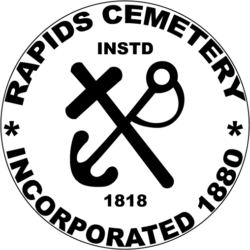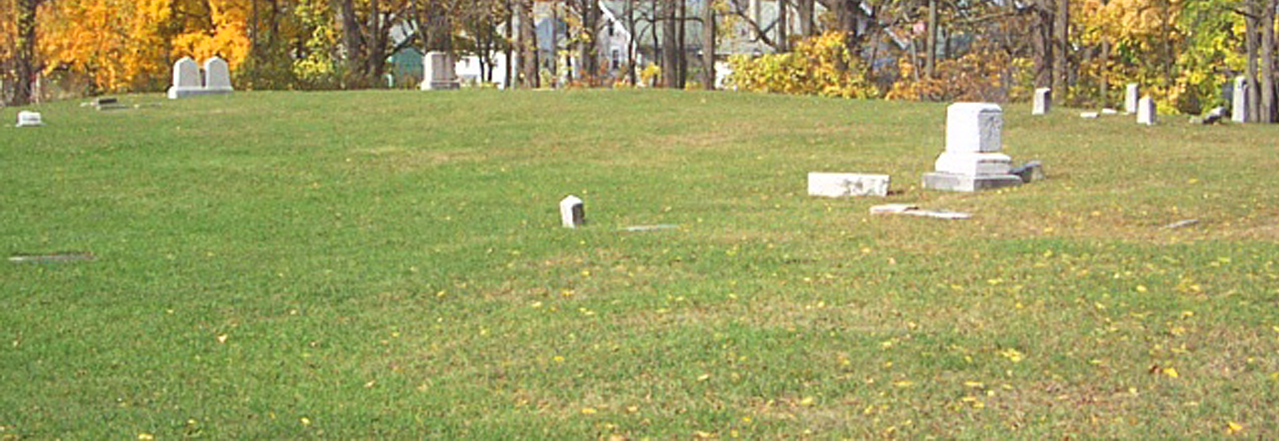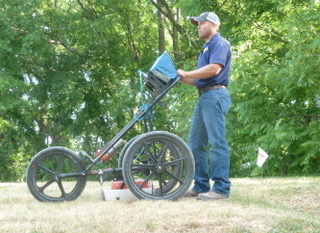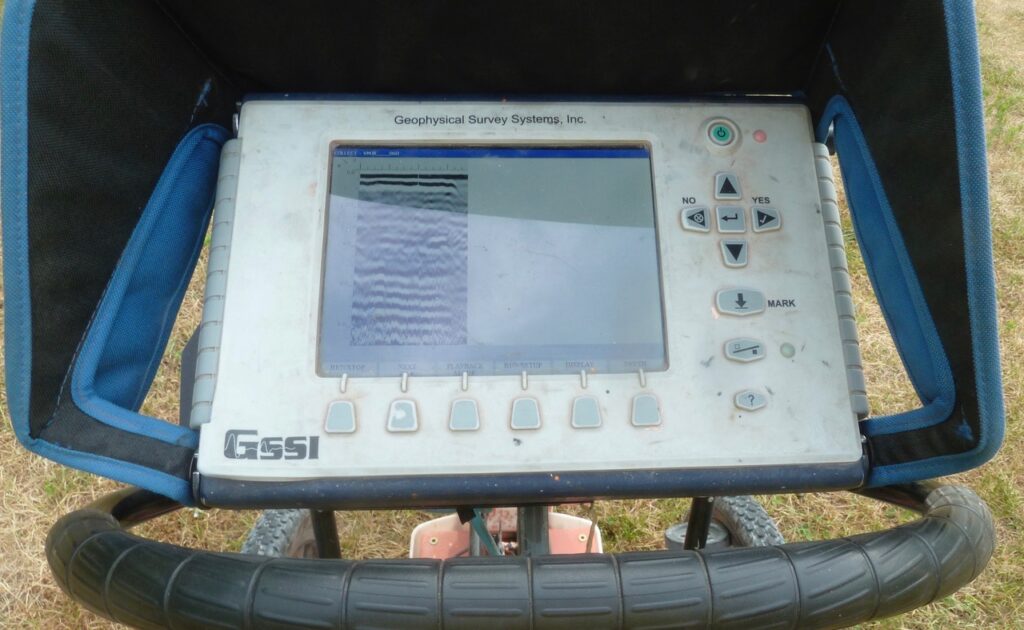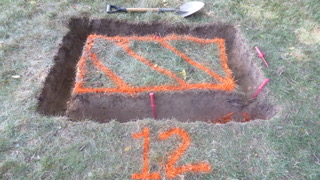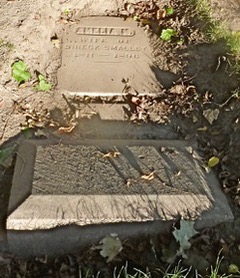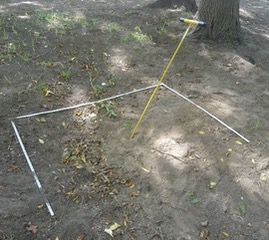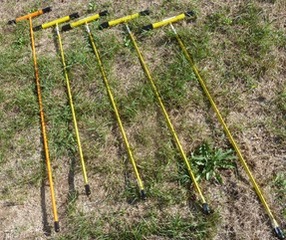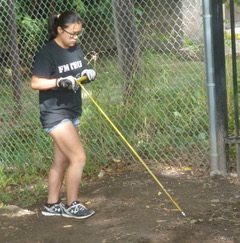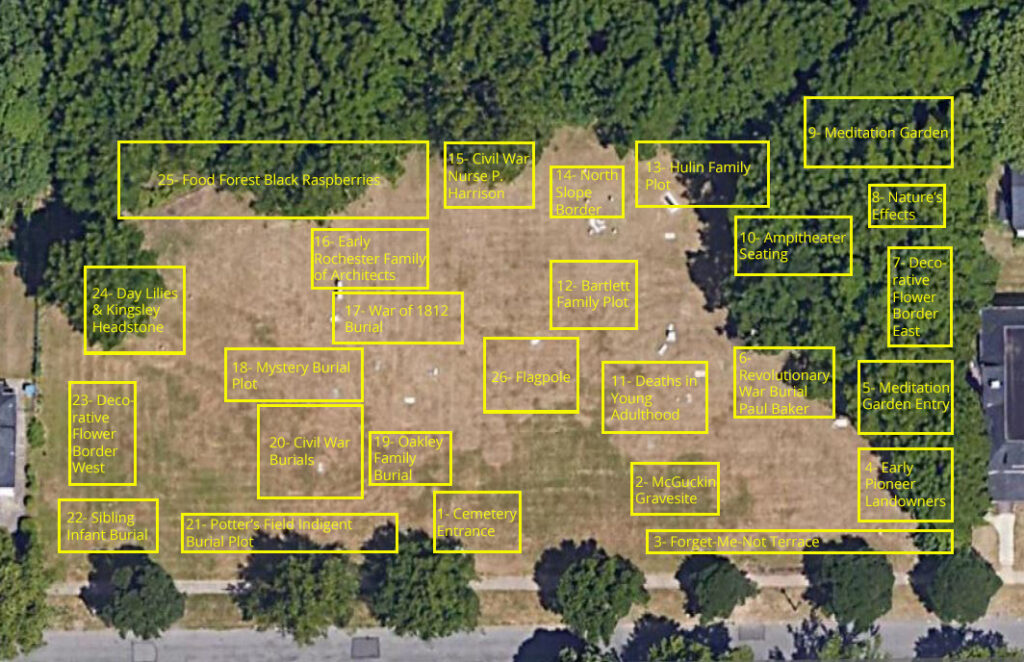
Headstones with Readable Inscriptions
There are few headstones visible today at Rapids Cemetery compared to the number of potential burials that took place here, as documented in the Loomis map. We knew it was possible that some headstones might have toppled and been covered with soil and grass over time. Therefore, in the summer of 2016, we employed Ground Penetrating Radar (GPR) to criss-cross the property and alert us to any possible below-ground headstones. At the time the GPR scanning was done, the back of the property was still so overgrown that the GPR equipment could not survey that area.
Only one headstone was discovered through the GPR process, and that one is the Smalley headstone at this Tour Stop. Also at this Tour Stop are the graves of the Hulin family, which were uncovered near the Smalley headstone after more undergrowth had been cleared in this area. Manual probing techniques were used to uncover those headstones.
Ground Penetrating Radar scanning
Very few headstones are evident today at Rapids Cemetery. It was hoped that the headstones had toppled and were covered by dirt. Ground Penetrating Radar was used with City permission in 2016 to locate underground objects up to a 6-foot depth. Most “hits” turned out to be unrelated modern-day artifacts like toys or metallized candy wrappers
A large anomaly shown on the GPR screen turned out to be the toppled three-part headstone of Amelia Smalley. It was uncovered using plastic trowels when the ground was soft.
Ground Penetrating Radar scanning was not possible where the wild vegetation blocked the wheeled GPR scanner. Manual probing tools with four and five-feet flexible shafts penetrated the cleared soft ground in the following spring. Probing indicated large objects beneath the topsoil at this location.
Tombstones Uncovered
Manual probing of the cleared northern border uncovered the Hulin Family tombstones with eloquent readable epitaphs. Careful removal of dirt using non-marring plastic tools and sprayed water revealed heartfelt sentiments.
Charlotte (Dutcher) Hulin (1816-1882)
Charlotte Dutcher, daughter of Jacob Dutcher and Elizabeth Philo, was born in Saratoga County NY on 16 December 1816. After the death of her sister Almira Harris in 1849, Charlotte raised her nephew Albert and niece Jane alongside her own daughters. She died on 27 December 1882. Charlotte’s headstone, like those of her daughters, had been covered with soil and turf for many decades prior to being unearthed by volunteers in August 2017. This served to protect the stones from the ravages of weather and vandalism and preserved the crispness of the inscriptions.
Plain water plus gentle scrubbing uncovered the epitaph of Charlotte Hulin, wife of Truman Hulin and mother of Emily and Matilda Hulin.
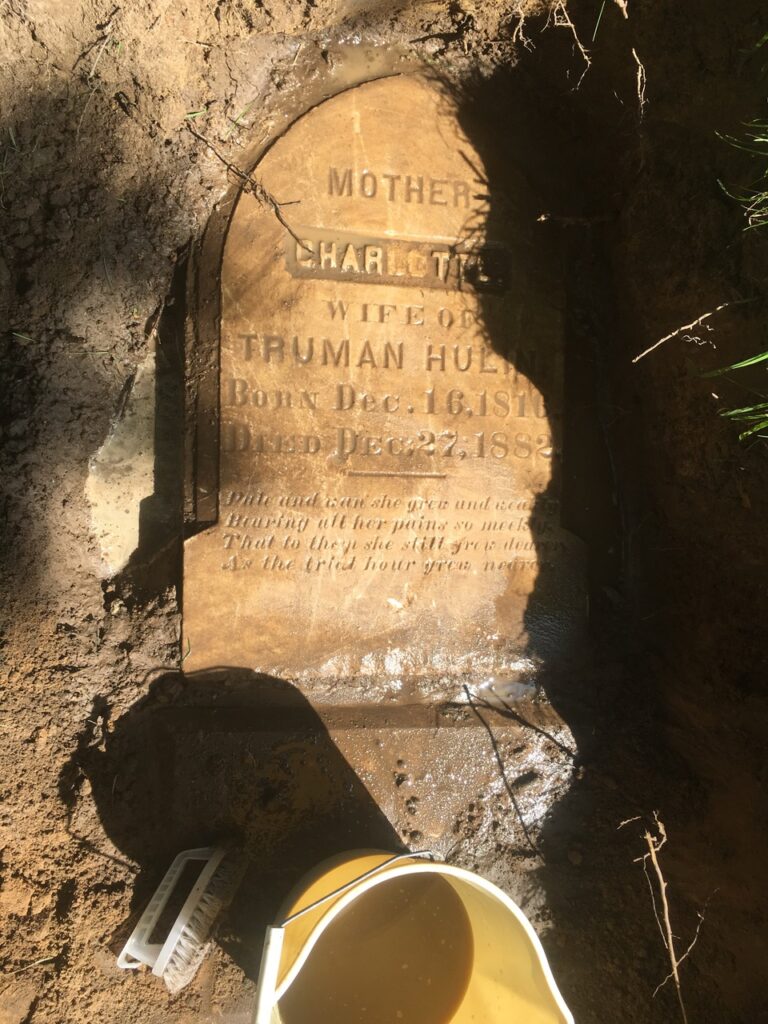
Mother
Charlotte
wife of Truman Hulin
Born Dec. 16, 1816
Died Dec. 27, 1882
Pale and wan she grew and
Weakly bearing all her pain so meekly
That to them she still grew dearer
As the trial hour drew nearer.
Matilda (Hulin)Willis (1939-1857)
Matilda Hulin, daughter of Truman and Charlotte, was born in Saratoga County NY in 1839. She moved with her family to the Rapids when about five years old. On 18 Sep 1855, she married Ira Willis Jr., a local boatman. Charlotte died on 14 June 1857 shortly after her eighteenth birthday. Ira remarried and is buried in Mount Hope with his second wife.
The uncovering of the Matilda Hulin Willis tombstone by Rapids Cemetery researcher Dr. Dan DeMarle and crew revealed the decorative feature of a detailed floral arrangement.
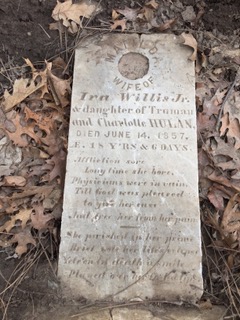
Matilda Wife of Ira Willis, Jr. & daughter of Truman and Charlotte Hulan Died June 14, 1857 Aged 18 years and 6 days Affliction sore Long time she bore. Physicians were in vain Till God was pleased to give her ease And free her from her pain. ———– She perished in her prime. Brief was her life’s eclipse. Yet e’en in death a smile Played o’er her faded lips.
Emily A. Hulin (1836-1862)
Emily Ann Hulin was born in December 1836 in Saratoga County NY, eldest known child of Truman and Charlotte. She moved to this neighborhood with her family about 1844 and attended school locally. On the morning of 25 January 1862, Emily was at the home of Samuel W. Hart, a prosperous farmer who lived west of the Rapids. She may have been employed there as a domestic but was also engaged to one of the Hart sons and the wedding was to take place within a few days. While cooking breakfast, she became unwell and went upstairs to her room. Later that morning she was found to be experiencing convulsions, the doctor was called but Emily died before he arrived. His opinion was that the death was due to natural causes and no post-mortem was warranted. The Coroner agreed. Truman and Charlotte laid Emily to rest beside her sister Matilda. The grieving parents became convinced that their daughter’s death was suspicious and obtained a judicial order to hold an inquest. Three weeks after Emily died, the body was exhumed, and a post-mortem performed. The doctors found no apparent cause of death, but the coroner’s jury was not satisfied and requested that the stomach contents be analyzed. This was not done. The inquest returned a verdict of “death from causes unknown.” Newspaper coverage at the time indicated that there were ill feelings amongst the interested parties, and they declined to report the testimony lest it worsen existing feuds.
The photo shows a headstone with readable inscriptions. It was preserved by being covered by dirt for roughly 100 years. Probing reveals there was something solid beneath the surface.
WATCH: Uncovering Emily’s stone (video credit: D. DeMarle)
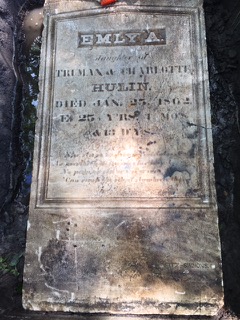
Emily’s headstone, found in Rapids Cemetery
Truman Hulin (c. 1807 – 1885)
Truman Hulin was born circa 1807, likely in Saratoga County NY but possibly in Massachusetts. He came to this area about 1844 with his wife Charlotte and two daughters. A third daughter was born at the Rapids. Truman worked as a whip maker and grocer until the mid-1860s when he became the proprietor of the American Hotel, located on the southeast corner of Brooks Avenue and Genesee Street. He operated the hotel and tavern until shortly after Charlotte’s death. In January 1883 he sold the business and property to Monroe Oakley (STOP 19) and moved to West Henrietta, possibly to live with his married daughter’s family. Truman died in February 1885 and is presumed to be buried in the family plot with his wife and daughters.
